When Mark Arigho’s in-laws suggested he might design a house in their overgrown garden, with its ivy-smothered trees, he was down among the leaves that very evening with a tape-measure.
While things didn’t measure up symmetrically – the site is angled on one side, up against a house on the other side and has a road running past at a slant – he was happy to work with that. The site in Foxrock, Dublin, is also in a conservation area and so step one was to go and look at the development plan.
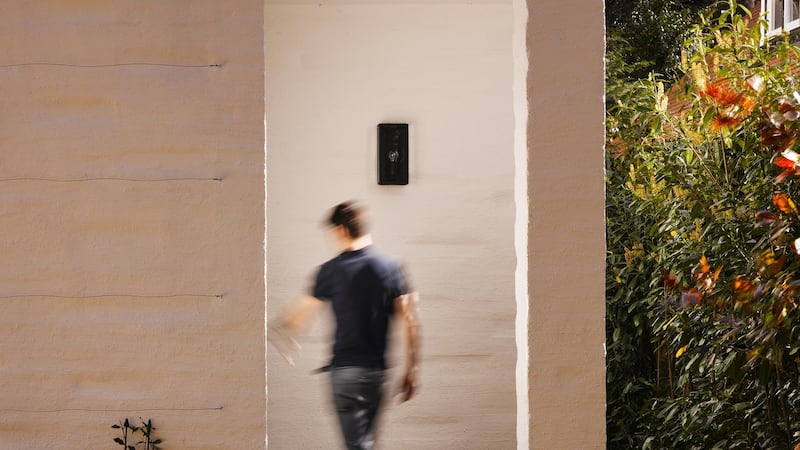
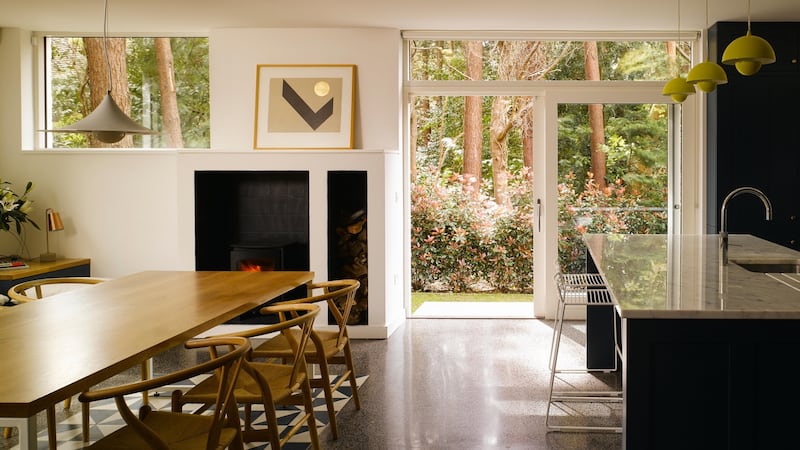
Such documents are "usually about the streetscape but in Foxrock it's the landscape" says Arigho who runs Arigho Larmour Wheeler Architects in Dublin and Belfast with Patrick Wheeler and Jane Larmour. The preserved sylvan setting of the leafy south-Dublin neighbourhood is not a random affair.
The house Arigho has built here treads lightly on the earth, with one end tip-toeing on mini piles above tree roots while beneath the drive is a mesh system that spreads the load of cars, dissipating possible stress on roots under the road.
In its living spaces and bedrooms the house generously engages with the exterior where things have been kept a bit wild – while the site was substantially tamed and the ivy untwirled from tree trunks, the garden is still very much a woodland.


No neat lawns and borders here. Great concrete steps descend from two sides of the kitchen/dining room (which is at the far end of the ground floor), providing the ‘stoop’ Arigho coveted. At the top of one set of steps are two Butterfly chairs, sourced online, whose leather seats are slung hammock-like on their metal frames allowing lounging and contemplating on a solid concrete plinth within nature.
These two windows in Foxrock show layers of planting, through the trees in the foreground to a neighbouring garden and trees across a road
From the island in the kitchen you look across to a corner sofa and up to two windows that frame outdoor plants, receding into the distance, without showing the ground they stem from.
This window placement was a trick picked up from Mexican architect Luis Barragan – who often referred to himself as a landscape architect because he placed as much emphasis on the exterior as interior.
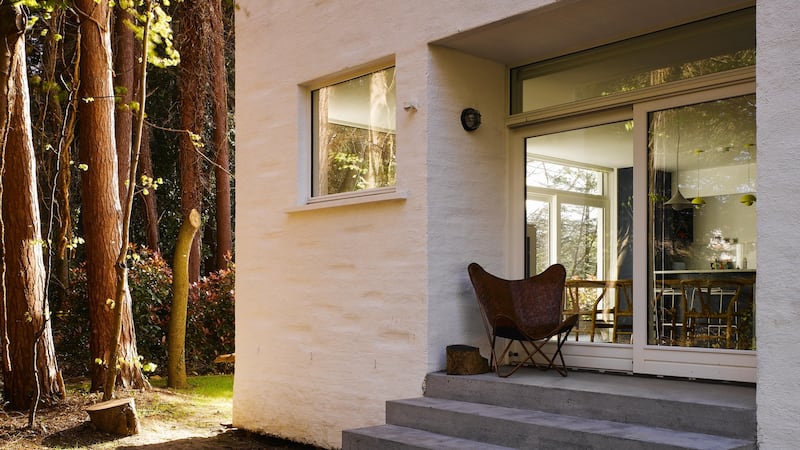
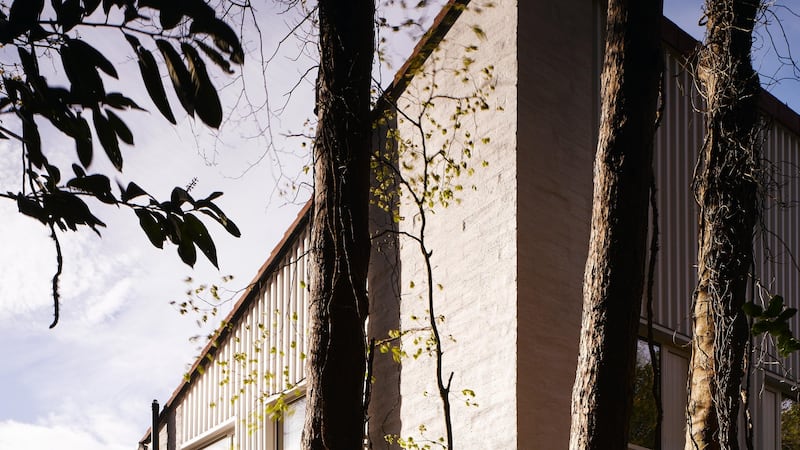
These two windows in Foxrock show layers of planting, through the trees in the foreground to a neighbouring garden and trees across a road. If the ground had been shown the view would shrink to garden and road. “If you strip out everything you just see a boundary,” says Arigho. “With the window placed here you can’t see the garden wall.”
Crucial role
He also borrowed the idea from Louis Khan (and popular with architects across Ireland) of having non-opening windows, to provide views and light without mullions, with a solid, timber opening to the side for ventilation.
With nature playing a crucial role in the design, the house treads delicately in other ways – for instance, it is purposefully not huge.
“There is no need in having bedrooms you don’t need,” says Arigho.
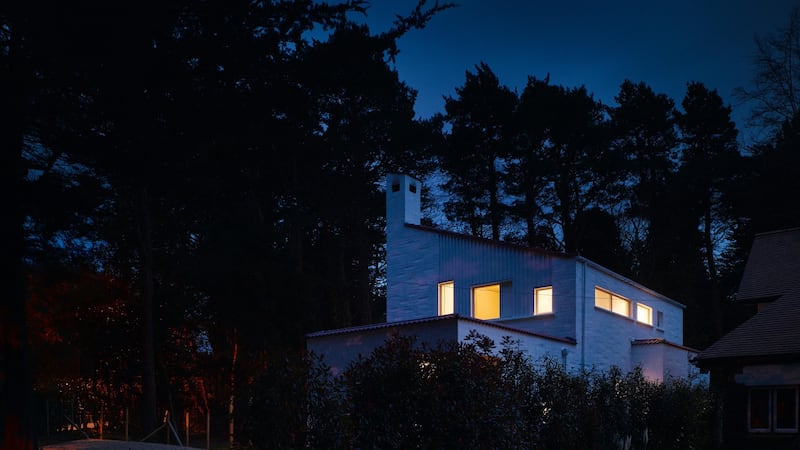
Downstairs there is a living room and a dining room/kitchen with a playroom off it so Mark and his wife, TV presenter Laura Woods, can keep an eye on their sons Ben and Alex while being able to close double-doors on toys in the evening.
The upper floor, with three bedrooms, has a smaller footprint than ground level. The two family rooms – one for parents and one for the boys – face east for awakening by the rising sun and to be among tree canopies on this garden side. “It’s like waking in a tree house,” says Arigho.
There is lots of built-in storage and generous swaths, including the kitchen/dining room and, perhaps counterintuitively, the entrance hall.
“Space as you enter a home is great,” says Arigho. “You are not all on top of each other.”
The entrance side of the house faces north and is quiet and solid, with no windows at ground level, to provide a screen from the road and a thermal barricade against northern weather. People also get protected from meteorologist attacks at the front door by a generous roof to fumble for keys under.
The outside of the house – in white – speaks to the Arts and Crafts and early Modernist heritage of the neighbourhood without being a pastiche. Arigho used more slender than standard breezeblocks for the exterior, from Roadstone, and steered from perfection and a flush facade by getting the builder to knock some of them inwards or outwards.
It drives me insane: I don't want a room to look like a Christmas tree
"They are purposefully not perfect, so you can read the blockwork underneath. Blockwork and plaster will always let you down so I designed 'imperfection' from the start," says Arigho who used to work at de Blacam & Meagher Architects and was prompted, by John Meagher, to visit the practice's Immaculate Heart of Mary Church at Rowlah in Co Dublin. Its "fantastic" interior – with blocks on their side - inspired the choice of breezeblocks in this house.
Polished concrete
Many of the interior elements, from the kitchen to the dining table, were designed by Arigho whose practice designs furniture for many of its projects. The kitchen floor is a sleek polished concrete from Roadstone (different companies provide different coloured aggregate, says Arigho, and here it is mainly black with white speckles) and countertops are in Carrara marble, with the doors in spray-painted MDF.
Yellow Panton Flowerpot lights dangle above the island. There are no downlights here or in the rest of the house: “It drives me insane: I don’t want a room to look like a Christmas tree.” All lights in the rooms, from task lights to wall lamps, come on with the flick of one switch.
The build took six months, from March 2016 to September.
“It was such a personal project for us,” says Arigho who describes drawing away and then coming downstairs to show Laura and ask her opinion. He also sometimes consulted his practice partners.
Every architect dreams of designing and living in their own house
“When I got stuck I would put a drawing under their noses,” says Arigho, who set up the practice with two others because he believes design is a collaborative process. “It shouldn’t be an insular activity, you need to bounce ideas off people.”
He counts himself very lucky. “Every architect dreams of designing and living in their own house. It is really great.”











